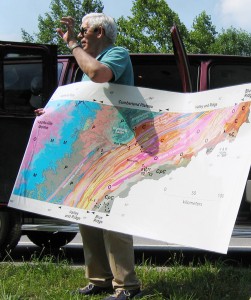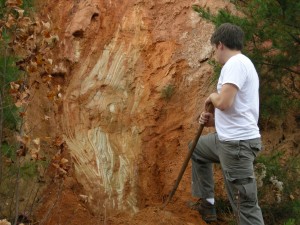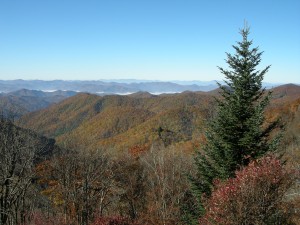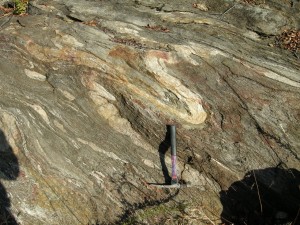 The primary reason I have spent almost all of my career in universities has been to work with students—in the classroom, in the field, and one on one. Much of my research could have been done in a non-university setting, e.g., a geological survey, petroleum company, or government research laboratory, but a university provides a multitude of opportunities for interactions with students and professional colleagues locally, nationally, and internationally. This fertile environment of interaction and cooperation continues to produce new ideas and opportunities to test ideas has made me a better teacher and better geologist in my life-long role of both long-time student and teacher.
The primary reason I have spent almost all of my career in universities has been to work with students—in the classroom, in the field, and one on one. Much of my research could have been done in a non-university setting, e.g., a geological survey, petroleum company, or government research laboratory, but a university provides a multitude of opportunities for interactions with students and professional colleagues locally, nationally, and internationally. This fertile environment of interaction and cooperation continues to produce new ideas and opportunities to test ideas has made me a better teacher and better geologist in my life-long role of both long-time student and teacher.
During my tenure Clemson University, I taught a variety of undergraduate courses, including mineralogy, petrology, optical mineralogy, structural geology, economic geology, environmental geology, and introductory courses (not every year). Undergraduates were frequently involved with me in senior research projects, both in the laboratory and in the field. There, I was also able to select one or two of the best undergraduates to work with me in the field during the summers on National Science Foundation-supported research projects. Undergraduates were able to learn the intricacies of field geology in a both physically and intellectually challenging environment in the western Piedmont and Blue Ridge of the Carolinas and northeastern Georgia.
 Moving to a graduate department in 1978 enabled me to concentrate on teaching structural geology courses, and occasionally courses in field geology and the geologic interpretation of geophysical data, the latter emphasizing the kinds of geophysical data most useful to understanding crustal structure (seismic reflection, aeromagnetic, gravity, and borehole geophysical data). Despite leaving a primarily undergraduate department to have more interactions with graduate students, I have continued to the present to teach undergraduate structural geology courses and to be involved with undergraduates in senior research projects. For the past two decades, I have taught undergraduate structural geology, advanced structural geology, tectonics, and Appalachian tectonics, in alternate years, and occasionally the geologic interpretation of geophysical data.
Moving to a graduate department in 1978 enabled me to concentrate on teaching structural geology courses, and occasionally courses in field geology and the geologic interpretation of geophysical data, the latter emphasizing the kinds of geophysical data most useful to understanding crustal structure (seismic reflection, aeromagnetic, gravity, and borehole geophysical data). Despite leaving a primarily undergraduate department to have more interactions with graduate students, I have continued to the present to teach undergraduate structural geology courses and to be involved with undergraduates in senior research projects. For the past two decades, I have taught undergraduate structural geology, advanced structural geology, tectonics, and Appalachian tectonics, in alternate years, and occasionally the geologic interpretation of geophysical data.
 The Knoxville area and the southern Appalachians are one of the best places in the world to teach and learn structural geology, stratigraphy and sedimentation, and petrology. It is possible to stand next to a thrust fault with 100 km of displacement and its collateral interactions with its hanging wall and footwall rocks within 10 minutes of the Department. It is possible to stand next to a thrust fault with >350 km of displacement, along with spectacularly folded low-grade metamorphic rocks within 35 minutes of the Department. Within an hour’s drive of the campus are high-grade metamorphic and igneous rocks. Similarly accessible within a short drive are classic stratigraphic sections of three Paleozoic Appalachian clastic wedges (Ordovician, Devonian, and Pennsylvanian), as well as sections in the Neoproterozoic to early Paleozoic rifted margin and platform sedimentary rocks. Only a few other universities in the US can boast of this kind of accessibility to such a multitude of geologic settings for both teaching and research. I have actually taught a class during a regular class period on one of the field sites in Knoxville wherein we left and returned to campus and had plenty of time to discuss the field relationships within the class period.
The Knoxville area and the southern Appalachians are one of the best places in the world to teach and learn structural geology, stratigraphy and sedimentation, and petrology. It is possible to stand next to a thrust fault with 100 km of displacement and its collateral interactions with its hanging wall and footwall rocks within 10 minutes of the Department. It is possible to stand next to a thrust fault with >350 km of displacement, along with spectacularly folded low-grade metamorphic rocks within 35 minutes of the Department. Within an hour’s drive of the campus are high-grade metamorphic and igneous rocks. Similarly accessible within a short drive are classic stratigraphic sections of three Paleozoic Appalachian clastic wedges (Ordovician, Devonian, and Pennsylvanian), as well as sections in the Neoproterozoic to early Paleozoic rifted margin and platform sedimentary rocks. Only a few other universities in the US can boast of this kind of accessibility to such a multitude of geologic settings for both teaching and research. I have actually taught a class during a regular class period on one of the field sites in Knoxville wherein we left and returned to campus and had plenty of time to discuss the field relationships within the class period.
